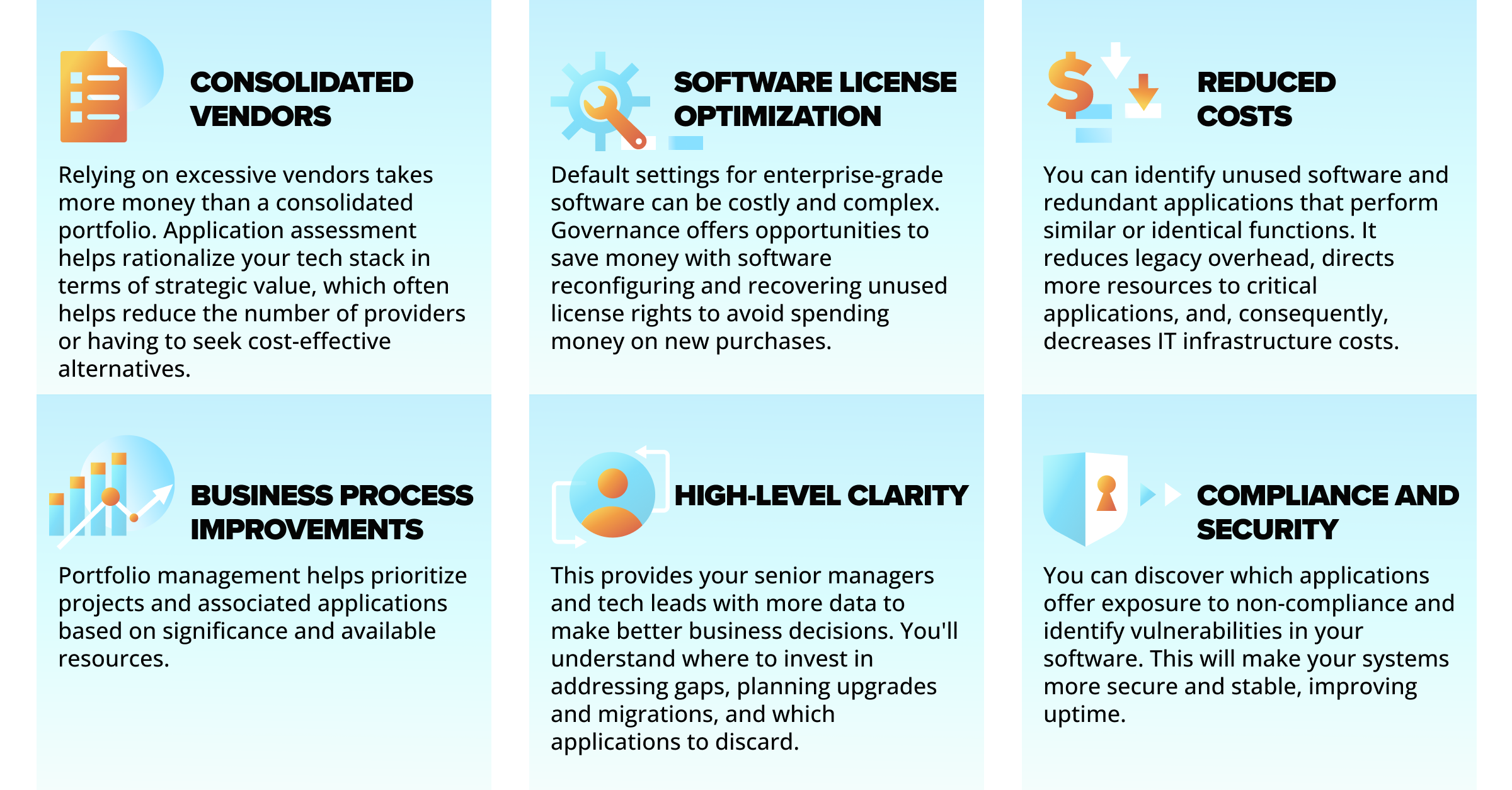How Application Portfolio Management Future-Proofs Your Business
It's easy to purchase cloud-based applications to solve urgent problems and enhance your business capabilities. But there's a catch. Applications can also deteriorate, become redundant, complicate your architecture, leave security gaps, and, most importantly, devour the budget. Does this sound like a challenge your enterprise faces? If so, you'll benefit from effective application portfolio management.
This article will discuss some of the best strategies to do it and provide you with a step-by-step application portfolio assessment guide. Let's begin with the basics of application portfolio management and its benefits.
What is application portfolio management?
Application portfolio management organizes software according to its value, costs, owners, technical feasibility, business capabilities, and supporting technologies. It also uncovers technical issues, overly complicated dependencies, and security risks. As a result, application management optimizes software and architecture to meet an organization's business goals.
A structured application portfolio for an enterprise isn't just recommended; it's necessary. So, before we talk about the process, let's examine its importance.
Why do enterprises need to manage their application portfolio?
SaaS solutions, hyperscalers, and other managed services can enhance your systems. However, don't forget that they are subject to ongoing change. As a result, their ability to support your business may degrade without proper management.
Besides, adding services without a long-term strategy often leads to other problems. For example, you could use similar tools performing the same tasks, incorrectly configured software, and license problems. All these issues can drive up your costs and slow down your systems.
So, what can you accomplish with application portfolio modernization?

Modernizing your application portfolio provides numerous benefits, and the crucial part of managing applications is to carry out an application portfolio assessment. First, let's look at a process roadmap.
Seven-Step Guide to Application Portfolio Assessment

Evaluating each application and the underlying technology can be time-consuming, but it's unwise to rush. Instead, the best approach is methodical, following these seven steps:
1.List your applications and business capabilities
Compile an enterprise architecture map with past, present, and future applications used throughout departments. Then link them to supporting IT components and the business capabilities they provide.
2.Identify the application's owners
Identify stakeholders responsible for the applications, primarily business and technical owners. It helps to know who to contact or secure approval for changes (reconfigurations, retirement, or migration).
This information provides an initial application landscape and a foundation for subsequent analysis.
3.Collect utilization metrics
Collect metrics about your applications' usage and complexity during a selected time frame. You may learn that some apps are used infrequently or have become unnecessary. Other tools may consume excessive computing resources and IT components.
Monitoring these metrics for a more extended period may also yield a broader view of your portfolio, offering a perspective on application necessity from a business standpoint.
4. Measure cost and value
Compare the total costs of ownership for applications with how effectively they support business processes. Then, compare your tools to similar software from other vendors.
Calculating the costs of applications is straightforward, and numerous software asset management tools are available to help. Measuring value, however, is complex. It might require employee or application owner interviews and questionnaires.
Remember that business value will change over time as applications age. Additionally, some applications are more expensive to maintain than others. Finally, some become prone to data breaches.
5. Determine the application's lifecycle
Applications nearing the end of their lifecycle have limited functionality, technical support, and little or no security updates. The correct software can help you identify such problems and plan for replacement.
Other cloud-based solutions may run on time-sensitive software licenses. So, these solutions need to be tracked if you don't want to lose essential business functions should someone forget to renew the license.
6. Evaluate technical feasibility
Analyze how the technical stack supports your applications. This process includes analyzing the following factors:
- Technological requirements (storage, bandwidth, IT support, and maintenance needed to keep them running)
- Hardware and software control (the update frequency and user and administrator effort)
- Interoperability standards (the degree of dependence on other applications and ability to migrate them without disruptions)
- Scalability (how difficult it is to add users or modify resources for specific applications)
- Cybersecurity (security mechanisms, your company's privacy policies, risk tolerance models, system vulnerability to attacks, and security controls)
This step might take the most amount of your effort. It's advisable to use a rating system to rank technical feasibility to prepare for the next step.
7. Plan future actions
Combine and evaluate data to prioritize portfolio improvement opportunities. We recommend categorizing your applications using Gartner's Time Model:

Remember to factor in the impact of changes to your portfolio. For example, answer these questions:
- What business capabilities will you affect as you modify an application?
- What are the cost benefits?
- Who are the stakeholders?
- What are the risks?
Effective application management should be continuous. The following section will show you how to automate and refine it.
Strategies to Help with Application Portfolio Modernization

Even though one-time assessment and modernization can help initially, these processes need to be ongoing to deliver long-term value:
1.Rationalize applications incrementally
The evaluation can be simple or highly complex, depending on the maturity of your organization. Here's a secret, though: you don't have to analyze everything to realize the value!
Your main goal should be to optimize critical applications, the technical stack, and your business capabilities. This will help you discover ways to "cut the fat" in three months or less. Then, you can gradually move on to other elements in your enterprise architecture and gain more value.
2.Review application fitness
An application fitness review requires a multifaceted assessment based on technical capability, the ability to support business processes, and the costs involved. Business indicators include information quality, timeliness, and the importance of supported functions. As for the technical factors, examine the applications' stability, maintainability, security, and reliance on human skills.
When planning an assessment, start by defining its purpose and scope of review. Larger enterprises should distribute assessment responsibilities between multiple teams (for example, separate units could perform business, technical, and cost fitness reviews). Plus, it's paramount to involve your senior managers and tech leads.
3.Senior management
According to research from University Twente in the Netherlands, many enterprises overlook stakeholder needs during the process of application portfolio management.
Identify technical leads, innovation managers, and senior management responsibilities. Then, create a framework for informing and securing approvals during decision-making.
To keep your stakeholders engaged, present information in an easily digestible, factual form. As stated in the research mentioned above, "visual representation is critical to sense-making decisions," and the value of visualization shouldn't be underestimated. Presenting data visually with interactive dashboards can help non-savvy managers understand your meaning. That's when specialized analytics software can help.
4.Use specialized management software
Software asset management and application portfolio management platforms can help automate data collection for software, licenses, IT components, and business capabilities. They could also present the information on a unified dashboard for immediate, real-time visibility of your portfolio. Consequently, your technical personnel and business managers will have an easier time managing your applications.
Benefits Far Outweigh the Effort

Today’s most successful companies know they must modernize their application stack to meet strategic objectives, mitigate security risks, and improve cost-efficiency. That's what you achieve with application portfolio management.
A portfolio assessment can help you deal with critical issues or prepare for mergers and acquisitions. Ongoing application management can also maximize efficiency and help in times of crisis.
As a software development company with nearly 29 years of experience, SoftServe understands why enterprises can struggle to reduce IT costs. Moreover, we know how to help you organize your application portfolio, simplify governance routines, optimize business capabilities, and automate application management processes.
Let’s talk about your application portfolio and help you develop a digital transformation roadmap.


